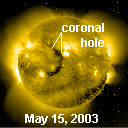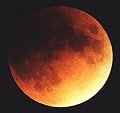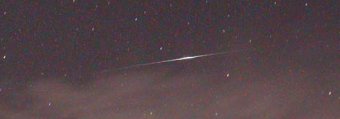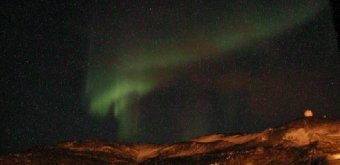|   SPACE WEATHER SPACE WEATHER
Current
Conditions
Solar Wind
speed: 612.9 km/s
density: 2.4 protons/cm3
explanation | more data
Updated: Today at 2255 UT
X-ray Solar Flares
6-hr max: B5 2140 UT May15
24-hr: B5 2140 UT May15
explanation | more data
Updated: Today at 2245 UT
Daily Sun: 15 May '03 
None of these small sunspots pose a significant threat for strong solar flares. Image credit: SOHO/MDI
The Far Side of the Sun

This holographic image reveals no large sunspots on the far side of the Sun. Image credit: SOHO/MDI
Sunspot Number: 75
What is the sunspot number?
Updated: 14 May 2003
Coronal Holes:

Earth could experience a brief solar wind gust from the indicated coronal hole on or about May 19th. Image credit: SOHO Extreme UV Telescope.
More about coronal holes Interplanetary Mag. Field
Btotal: 5.4 nT
Bz: 2.9 nT south
explanation | more data
Updated: Today at 2257 UT
 SPACE WEATHER SPACE WEATHER
NOAA
Forecasts
Solar Flares: Probabilities for a medium-sized (M-class) or a major (X-class) solar flare during the next 24/48 hours are tabulated below.
Updated at 2003 May 15 2200 UTC
| FLARE | 0-24 hr | 24-48 hr | | CLASS M | 10 % | 15 % | | CLASS X | 01 % | 01 % |
Geomagnetic Storms: Probabilities for significant disturbances in Earth's magnetic field are given for three activity levels: active, minor storm, severe storm
Updated at 2003 May 15 2200 UTC
Mid-latitudes | 0-24 hr | 24-48 hr | | ACTIVE | 25 % | 25 % | | MINOR | 15 % | 10 % | | SEVERE | 05 % | 01 % |
High latitudes | 0-24 hr | 24-48 hr | | ACTIVE | 35 % | 35 % | | MINOR | 15 % | 15 % | | SEVERE | 05 % | 05 % |
| | What's Up in Space -- 15 May 2003
Subscribe to Space Weather News!  LUNAR ECLIPSE: The full moon is about to glide through Earth's shadow and turn a lovely shade of sunset-red; it's the first lunar eclipse of 2003. When to look: Thursday night, May 15th, if you live in North or South America; Friday morning May 16th, if you live in Europe. Follow the links below for more information. LUNAR ECLIPSE: The full moon is about to glide through Earth's shadow and turn a lovely shade of sunset-red; it's the first lunar eclipse of 2003. When to look: Thursday night, May 15th, if you live in North or South America; Friday morning May 16th, if you live in Europe. Follow the links below for more information.
ECLIPSE BONUS: IRIDIUM FLARES Sky watchers in the western and central United States are favored to see some pleasing Iridium flares during tonight's lunar eclipse. "Some cities that will have decent flares are Phoenix, Salt Lake City, El Paso, Minneapolis, Omaha and Missoula," says space scientist Rob Matson of SAIC, who also forecasts Iridium flares for the International Space Station. (continued below) 
Above: Connie Corbett photographed this Iridium flare over cloudy California on May 8th. Most of tonight's flares will appear higher in the sky than the moon. "With a wide field of view camera, however, it may be possible to capture a flare and the moon in the same field of view," notes Matson. When and where should you look? Check Heavens Above for details about your home town. ECLIPSE BONUS: SPACE STATION This is for advanced observers. Along a narrow path (only 1 or 2 miles wide) stretching from Dallas through St. Louis to Chicago, sky watchers can see the International Space Station pass in front of the eclipsed moon tonight. Like the moon itself, the ISS will be inside Earth's shadow, so it will be dark--a ghostly silhouette racing across the dimly-lit lunar terrain in less than a second. You have to be at the right place at the right time to see it. Thomas Fly has prepared maps and timetables for the central United States and other places where these transits may be visible.  Would you like a phone call when the International Space Station is about to fly over your backyard? Sign up for Spaceweather PHONE. Would you like a phone call when the International Space Station is about to fly over your backyard? Sign up for Spaceweather PHONE.
ANTARCTIC AURORAS: Night has fallen and the sun won't come up again until August, but it's not completely dark at McMurdo Station, Antarctica. That's because auroras have been lighting up the skies. McMurdo resident Tom Hamann captured this picture of the Southern Lights on May 11th: 
"We don't see good auroras at McMurdo very often," says Hamann. Auroras circle Earth's magnetic poles like a donut, bright around the rim and dark in the middle. "Because we're fairly close to the south magnetic pole, we're usually inside the donut where auroras are dim. Faint auroras are hard to see here in 'town' because there is so much light pollution." The orange color of the foreground, he says, is due to 'city lights' reflecting from some fog and low-lying clouds. Earth is inside a high-speed solar wind stream that could trigger more auroras tonight. The best observing sites will be at high latitudes: e.g., the southern regions of New Zealand and Australia, northern Europe, Canada, Alaska and northern US states such as Michigan and Wisconsin. WEB LINKS: NOAA FORECAST | GLOSSARY | SPACE WEATHER TUTORIAL | BECOME A SUBSCRIBER | SpaceWeather PHONE | 
Potentially Hazardous Asteroids (PHAs) are space rocks larger than approximately 100m that can come closer to Earth than 0.05 AU. None of the known PHAs are on a collision course with our planet, although astronomers are finding new ones all the time.
On 15 May 2003 there were 511 known Potentially
Hazardous Asteroids May 2003 Earth-asteroid encounters Notes: LD is a "Lunar Distance." 1 LD = 384,401 km, the distance between Earth and the Moon. 1 LD also equals 0.00256 AU. MAG is the visual magnitude of the asteroid on the date of closest approach.
 - LEONIDS 2002: The Leonids have come and gone, but our meteor gallery keeps growing. Check out the latest additions, which include a stunning image of 44 meteors emerging from the radiant in Leo.
- DAWN PLANETS: Just before dawn on Sunday, Dec. 1st, the planets Venus and Mars converged and formed a lovely triangle with the slender crescent Moon. [gallery]
- SUMMER AURORAS: August was a good month for auroras. Visit our gallery and see what happened in the skies of Europe and North America.
- NEARBY ASTEROID: Asteroid 2002 NY40 came so close to Earth on August 18th that people could see it through binoculars or small telescopes. [gallery]
- PERSEIDS 2002: Sky watchers spotted plenty of bright shooting stars--including some colorful earthgrazers--during the 2002 Perseid meteor shower. [gallery]
- AURORA SURPRISE: An unexpected geomagnetic storm began on August 1st as night fell across North America. Sky watchers spotted vivid auroras over both the United States and Canada.
- CRESCENT SUN: See strange shadows, weird sunsets, eclipse dogs, crescent-eyed turkeys and extraordinary rings of fire photographed during the June 10th solar eclipse. [gallery]
|

